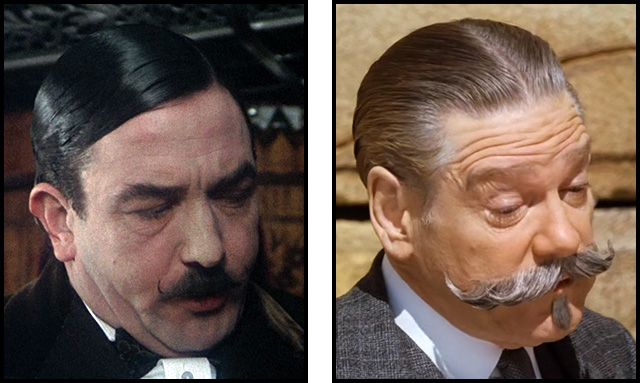
Agatha Christie, Paul Dehn, and Sidney Lumet, 1974

Agatha Christie, Michael Green, and Kenneth Branagh, 2017
 mild spoilers
mild spoilers
#210, 2017 Skandies
The difference between these two movies can be summed up in the following two images:

Agatha Christie, Paul Dehn, and Sidney Lumet, 1974 
Agatha Christie, Michael Green, and Kenneth Branagh, 2017  mild spoilers
mild spoilers
#210, 2017 Skandies The difference between these two movies can be summed up in the following two images: |

|
On the left is Hercule Poirot as depicted in the 1974 adaptation of Agatha Christie’s Murder on the Orient Express. He looks pretty much exactly like the guy on the cover of the books. Note the distinctive pair of upturned moustaches so central to the look of the character. On the right is Hercule Poirot as depicted in the 2017 adaptation. A mere two moustaches? Bah! Insufficient! He must have four! A pair of upturned moustaches on top of yet another pair of upturned moustaches! For this is the loudness war version of Murder on the Orient Express, and everything’s gotta be turned up to eleven. The train stopped by a mere snowdrift on the railway? Bah! An avalanche has to hit the train and derail it! And the train should be stopped on a tall, treacherous scaffold so that there can be a chase scene with boards collapsing under people left and right! Oh, and there’s a gun in the story, so Poirot needs to get shot! As for the dagger in the story that Mrs. Hubbard finds in her purse? This time around she can find it in her back instead! And hey, remember how Count Andrenyi is supposed to have a hot temper? Let’s have him express that temper through roundhouse kicks! That’s what you think of when you hear the name “Agatha Christie”, right? All the roundhouse kicks? I mean, it’s not that the 1974 version is any kind of masterpiece. It is about as straight a translation from book to screen as you could expect, and that means that it’s not particularly cinematic. A whole lot of talking heads on cramped sets. But the 2017 version is cinematic in the worst way: it follows all the tiresome Hollywood formulas. “Raise the stakes”? I’ve already talked about some of the laughable ways it does that. Ticking clock, check. Open with a little set piece showcasing the hero, check. And then of course there’s the mantra that the hero must have an internal conflict to go along with the external conflict. This is the big change, more than the conflation of the colonel with the doctor or the conflation of Count Andrenyi with Chuck Norris: the actual solution of the case is made secondary to how that solution shakes Poirot’s view of the world. Because this Poirot is weirdly derivative, partially of the Robert Downey Jr. version of Sherlock Holmes (in the little set piece, solving a mini mystery before an angry horde, Poirot predicts the baddie’s movements several turns in advance and places a cane just so to trip him up), but especially of Adrian Monk. This Poirot is obsessed with everything being balanced and even, and laments how his uncanny ability to see when things are out of place is both a gift and a curse. So whereas in the book and the 1974 movie, Poirot puckishly decides that the titular murder was justified, leading to an almost jovial denouement, the 2017 movie ends on a note that is somber, even bleak. This was actually one of the changes that bothered me least, but Ellie absolutely hated it. She hated it almost as much as the use of computer-generated imagery throughout the film, and yeah, the long shots of the train do make it look like it is hurtling across a Civilization VI map. In particular, she hated the way CGI was used to make Poirot’s eyes a more intense blue, to the point that they glowed. Call him two parts Poirot, three parts Monk, one part Downey Jr. Holmes, and one part Night King. 
Agatha Christie, Julian Fellowes, Tim Rose Price, and Gilles Paquet-Brenner, 2017 We also took a look at this one, since we’d already listened to the audiobook on one of our road trips. Ellie’s observation was that the most interesting thing about the book was that the initial murder turns out to have been committed for the most trivial of reasons—that’s a big part of the horror of it, that the killer takes life so very lightly—and this movie undermines that by trying to build up the motive into something that is hugely important to the murderer. I agree, though I understand the filmmakers’ thinking. It’s tricky enough when a book hangs the solution to a mystery on an offhand reference—but at least you can linger over every word of every line and try to keep a mental catalogue of clues. In a movie (or audiobook, for that matter!), conversations whip by in real time and it’s very likely that the majority of the audience will have forgotten the key reference without a few reminders. So it’s kind of a no-win situation. My observation is this: when we started up the movie, Ellie asked whether this was a sequel to the 2017 Murder on the Orient Express, because she didn’t want to see any more movies with four-moustache Poirot. She was surprised when I reminded her that Crooked House didn’t have Poirot in it at all. The detective is actually Just Some Guy. But, in retrospect, it kind of has to be that way. Because another big twist in Crooked House is that an unlikely character discovers who the murderer is ahead of anyone else and undertakes a successful suicide mission to protect the world from this psychopath. The supposed detective only finds the solution to the mystery after the fact. So Agatha Christie couldn’t have put Poirot in that role. It would’ve been bad for his image!
|
|||||||||||||||||||||